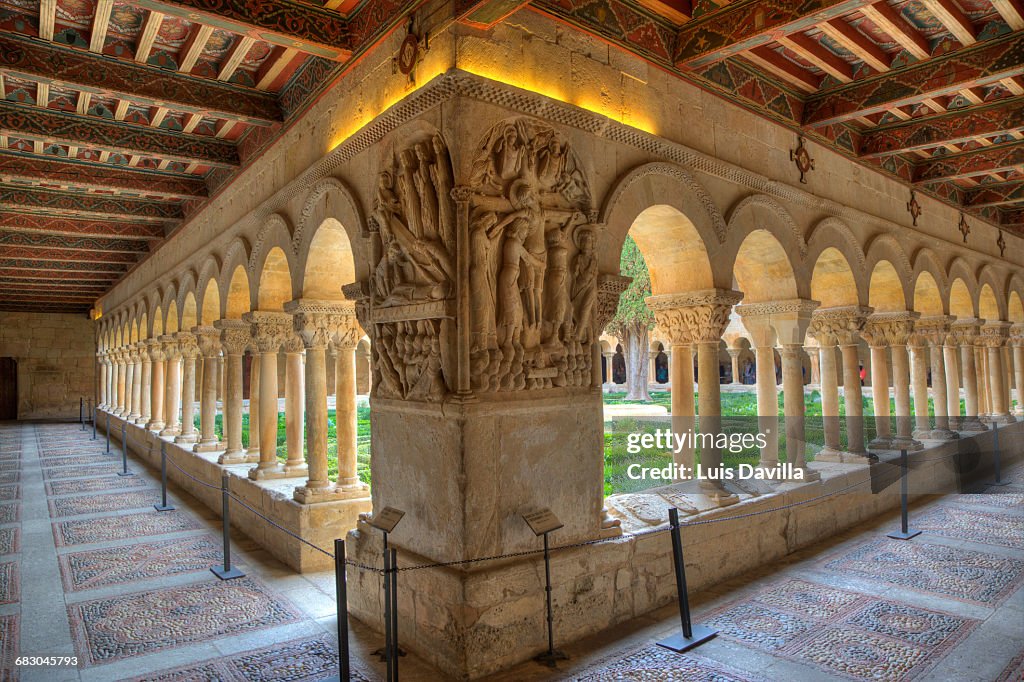Foto de stock de Cloister of Santo Domingo de Silos Abbey. Burgos
the Santo Domingo de Silos Abbey. Some researchers have suggested that this Benedictine abbey is linked to the history of the Cid, because Rodrigo Diaz de Vivar (the Cid) and his wife Doña Jimena donated some of their lands to the monastery in 1081, year in which the Cid was banished.As early as the Visigoths period there was a monastery dedicated to St. Sebastian, which was refurbished and expanded by Count Fernan Gonzalez. Around 1042 the building underwent another deep refurbishment under the initiative of a monk of La Rioja named Domingo. This monk, Prior of San Millán de la Cogolla Abbey, took refuge in Castile while escaped from the king of Navarra. Domingo promoted the religious community, commissioned by King Ferdinand I, undertaking a magnificent Romanesque building, which only the cloisters and the Door of the Virgins (in Spanish, the Puerta de las VÃrgenes) are preserved. The rest of the building dates from the 18th and 19th centuries, basically in Neoclassical style, involving to, among others, the Master Ventura RodrÃguez.The capitals (topmost member of the columns) of the cloister are magnificent. In them, a vast iconography was developed with outstanding examples clearly rooted in Andalusian art.Among the monastic spaces, there is also a 18th-century pharmacy, with a beautiful collection of Spanish pottery, and a museum, where are exposed: Mozarabic and Romanesque sculptures, remains of the old abbey, metalwork, porcelain enamels, etc.The abbey is also famous because the monks are one of the best exponents of Gregorian chant.

Tenha essa imagem em diversas opções de enquadramento no Photos.com.
COMPRAR UMA LICENÇA
Todas as licenças royalty-free incluem direitos de uso global, proteção abrangente, preços simplificados com possibilidade de desconto por volume
R$ 3.000,00
BRL
DETALHES
Crédito:
ID Criativo:
683045793
Tipo de licença:
Coleção:
Stockbyte
Tamanho máximo do arquivo:
5625 x 3745 px (47,63 x 31,71 cm) - 300 dpi - 20 MB
Data do upload:
Local:
santo domingo de silos, burgos, Spain
Info sobre autorização:
Não requer autorização
Categorias:
- Abadia - Mosteiro,
- Anos 1000,
- Arco - Característica arquitetônica,
- Arquitetura,
- Barreira de Corda,
- Burgos,
- Catolicismo,
- Claustro,
- Coluna arquitetônica,
- Cor Creme,
- Corredor,
- Cultura Espanhola,
- Destino turístico,
- Dia,
- Entalhe,
- Espanha,
- Estrutura construída,
- Fileira,
- Fotografia - Imagem,
- Grama,
- História,
- Horizontal,
- Imagem a cores,
- Interior,
- Local religioso,
- Mosteiro,
- Ninguém,
- Passado,
- Religião,
- Românico,
- Santo Domingo De Silos,
- Tranquilidade,